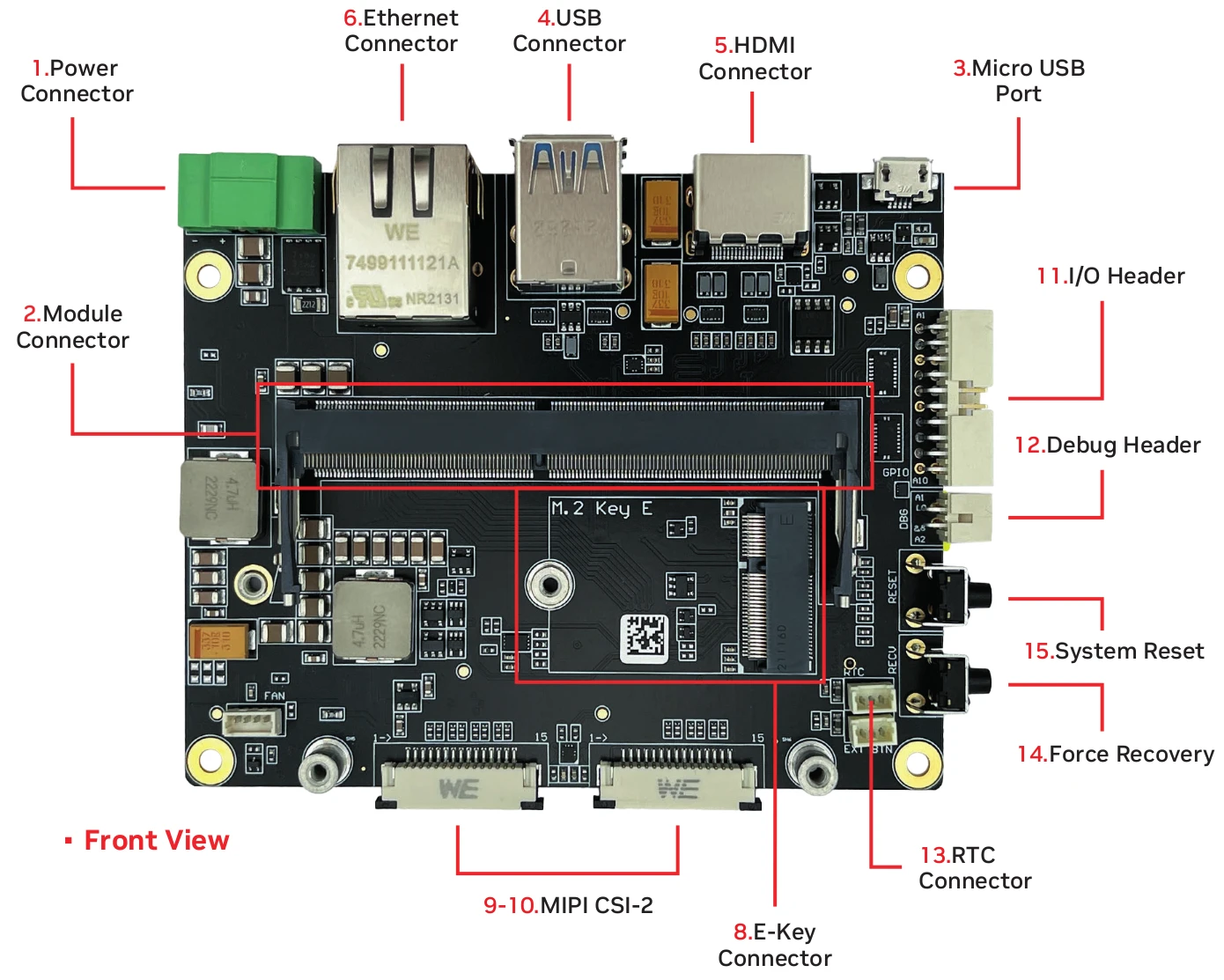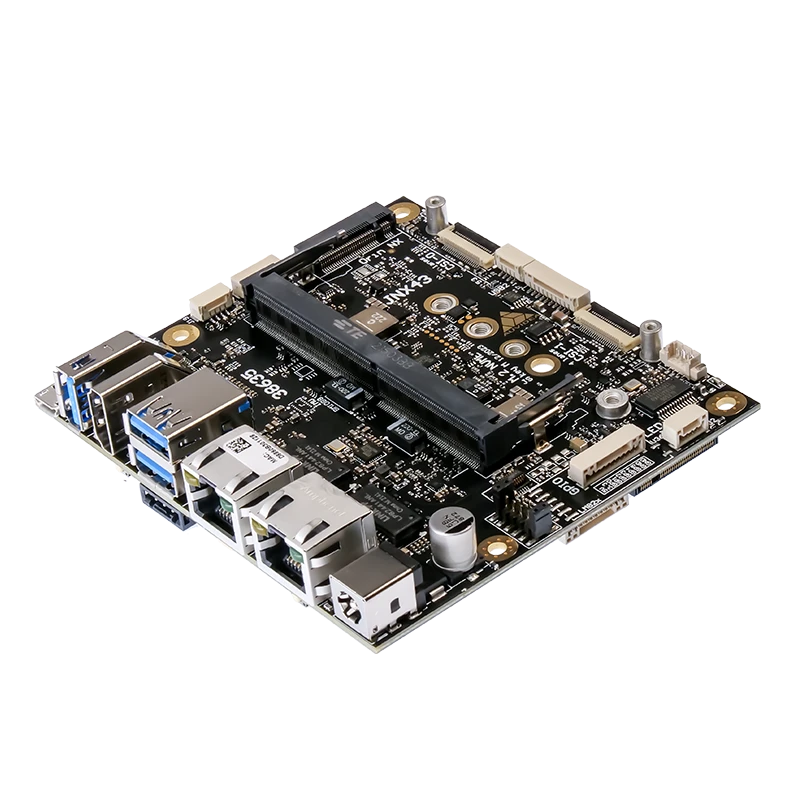Latest Posts ⚡
What Is a Jetson Carrier Board and How to Choose the Correct One?

When diving into edge AI development with NVIDIA Jetson modules, it’s easy to focus on the powerful compute modules like Jetson Nano, Xavier NX, Orin or Thor. But it is also very important to have the right carrier board for your project.
In this post, we’ll unpack what a Jetson carrier board is, its functions, components, and how to choose the right one for your project. Whether you’re a hobbyist, engineer, or product designer, understanding carrier boards is critical to building scalable and reliable edge AI solutions.
What Is a Jetson Carrier Board?
At its core, a carrier board is a printed circuit board (PCB) that breaks out the functionality of a Jetson module and provides the necessary interfaces, power rails, and connectivity for the module to operate in the real world.
Think of the Jetson module as the “brain” — it houses the CPU, GPU, memory, and storage — while the carrier board is the “body” that connects it to the outside world.
Jetson modules are designed as System on Modules (SoMs), meaning they’re compact, self-contained compute units that require a carrier board to connect peripherals like cameras, displays, USB devices, and networking interfaces.

Jetson carrier board showcasing I/O and expansion ports
Functions of a Carrier Board
A Jetson carrier board performs several key roles:
- Power Rails: Regulates and distributes the correct voltage and current to the module and peripherals.
- Interface Expansion: Provides connectors for USB, Ethernet, HDMI/DisplayPort, CSI (camera), PCIe, UART, I2C, SPI, and more.
- Peripheral Support: Enables connectivity for devices like cameras, SSDs, Wi-Fi/Bluetooth modules, and sensors.
- Debugging and Development: Offers serial console access, recovery mode toggles, boot switches, and sometimes JTAG headers.
- Cooling Integration: Many boards support fan control and thermal management to keep the module within safe operating temperatures.
Key Components on a Carrier Board

Here are some of the essential components you’ll find on a typical Jetson carrier board:
- Power Management ICs: Ensure proper power sequencing and conversion for the module and peripherals.
- USB/Ethernet PHYs: Handle data link-level communication for USB and network interfaces.
- Video Output Interfaces: HDMI, DisplayPort, or eDP output components for connecting external displays.
- MIPI CSI Connectors: For camera input — often with multiple lanes for high-bandwidth sensors.
- Connectors and Expansion Headers: Such as GPIO, I2C, SPI, CAN, and UART headers for integrating custom electronics.
- ESD Protection and Level Shifters: For signal integrity and protection against electrostatic discharge.
- Clock Generators: Provide stable timing signals required by some interfaces or modules.
- Microcontrollers (on some boards): Used for fan control, power sequencing, or even watchdog functionality.
Drivers and BSP: Making the Hardware Work
A carrier board is only as good as its software support, and that’s where the Board Support Package (BSP) comes in.
What is a BSP?
The BSP is a collection of software that includes:
- Bootloader
- Linux Kernel
- Device Trees
- Drivers
- User-space utilities
It tells the Jetson module how to communicate with the hardware on the carrier board. Each board may need a custom device tree and sometimes even kernel patches to support specific peripherals or configurations.
NVIDIA provides a BSP through its L4T (Linux for Tegra) platform, but third-party carrier board vendors often release their own BSPs or overlays to ensure full compatibility.
Constraints and Considerations When Choosing a Carrier Board
When selecting a carrier board, several key factors come into play:
1. Module Compatibility: Not all carrier boards support all Jetson modules. The Orin NX, AGX Orin and Thor have different form factors and power consumptions.
2. Form Factor: Consider the size and layout of the board — compact boards are ideal for drones and robots, while full-sized options are better for industrial deployments.
3. I/O Requirements: Define your needs for USB ports, video outputs, CSI camera lanes, Ethernet (1GbE vs 10GbE), CAN bus, and other interfaces.
4. Thermal Design: Will your application operate in a sealed enclosure? Does it require active cooling? Make sure the carrier board supports appropriate thermal solutions.
5. Power Supply: Check input voltage ranges and power requirements. Some boards support wide input ranges or even PoE (Power over Ethernet).
6. Environmental Constraints: Industrial-grade boards may offer extended temperature ranges, shock/vibration resistance, and conformal coating.
7. Software and Community Support: Well-documented boards with an active support community or vendor-provided BSPs reduce development time and risk.
Compatibility Between Jetson Modules and Carrier Boards
A common point of confusion is the interchangeability of Jetson modules and carrier boards. While some boards claim compatibility across multiple modules, real-world deployment can be tricky.
Key areas to check:
Pin Compatibility: Xavier NX and Orin NX share the same 260-pin connector, but Orin Nano has some functional limitations.
Mechanical Fit: Ensure the heatsink and connector layout aligns between module and carrier.
Power Delivery: Orin modules can demand more power than earlier modules. Ensure the board supports this.
BSP Compatibility: Using an Orin NX module on an older Xavier board may require BSP patches or kernel updates.
Conclusion
Jetson carrier boards are more than just breakout boards — they are critical enablers for deploying edge AI solutions. Whether you’re building a smart camera, autonomous robot, or industrial AI gateway, choosing the right carrier board impacts performance, reliability, scalability, and time-to-market.
Understand your project’s requirements, verify compatibility, evaluate software support, and choose a board that can grow with your system’s needs.

